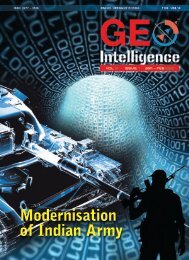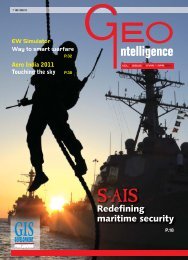Download PDF - GeoSpatialWorld.net
Download PDF - GeoSpatialWorld.net
Download PDF - GeoSpatialWorld.net
Create successful ePaper yourself
Turn your PDF publications into a flip-book with our unique Google optimized e-Paper software.
has seen a huge growth and an<br />
alternative route to cater to further<br />
growth was greatly needed.<br />
To address both these issues,<br />
MMC-Gamuda Joint Venture presented<br />
the idea of incorporating two<br />
major infrastructure components<br />
into one mega structure to the Government<br />
of Malaysia which gave the<br />
project a go ahead in 2003.<br />
Smart features<br />
The Stormwater Management and<br />
Road Tunnel, better known as<br />
SMART, started construction work<br />
in January 2003. The project<br />
demanded the effort and expertise<br />
of many - from supply of two slurry<br />
mixshield tunnel boring machines<br />
(TBMs) of more than 13 metre diameter<br />
to solving the complex engineering<br />
issues of combining two different<br />
uses in one tunnel, from supply<br />
of bentonite and M&E fittings to<br />
employing the workforce and the<br />
services of international and<br />
domestic leaders in their field. Part<br />
of the challenge was dealing with<br />
the soil condition of Kuala Lumpur<br />
which mostly consists of karstic<br />
limestone and alluvium with many<br />
cavities and pinnacles.<br />
Hence, managing advance of the<br />
tunneling machines and progressing<br />
major surface and open cut<br />
works to refining the operating<br />
standards and protocols for the<br />
safest operations of the dual purpose<br />
facilities were of utmost<br />
importance.<br />
Early results of the 3D modelling<br />
of reflected features at up to 40 m<br />
ahead were promising but the necessary<br />
sensors on the rotating cut-<br />
Geospatial World I September 2010<br />
terhead didn't survive the harsh<br />
environment of the limestone excavation<br />
process and had to be<br />
removed and improvement was<br />
made onto the casing for better and<br />
more robust protection. Being able<br />
to "see" ahead of the tunnel face<br />
however remained a high profile<br />
objective and therefore other methods<br />
of geotechnical survey techniques<br />
were also applied, such as<br />
microgravity, cross hole seismic<br />
survey, ground pe<strong>net</strong>rating radar<br />
and 2D resistivity tomography. The<br />
most beneficial of these was resistivity,<br />
a technique that detects<br />
changing resistivity of features within<br />
the ground to identify potential<br />
anomalies such as karst voids and<br />
fissured rock.<br />
Mechanical and electrical<br />
components<br />
Smart Tunnel is a dual purpose tunnel,<br />
incorporating a double deck<br />
motorway within the middle section<br />
of a stormwater tunnel. It was completed<br />
on 30 June, 2007. The completion<br />
of the Smart Tunnel is attributed<br />
to the implementation of innovative<br />
technologies and skilled team<br />
players. Being the first of its kind in<br />
its concept as a whole, there were<br />
indeed many firsts for the Smart<br />
team. In dealing with the dual purpose<br />
tunnel, amongst the most<br />
important components are the M&E<br />
equipment that can withstand the<br />
dual environment conditions - both<br />
wet and dry.<br />
Smart operations<br />
Smart Tunnel is designed first and<br />
foremost for flood control and as<br />
such stormwater operation mode<br />
will always over-ride the motorway<br />
operation mode. To ensure this protocol<br />
is maintained, the decision to<br />
close the motorway section for flood<br />
operation has been retained with<br />
the Government through its agency,<br />
Department of Irrigation and<br />
Drainage, Malaysia (DID).<br />
Three modes of operation:<br />
Mode 1 - no storm. For most time of<br />
the year, there is no storm or low<br />
rainfall, which means no diversion<br />
of water flow from the upstream<br />
confluence of the Klang River and<br />
Ampang River through Smart infrastructure<br />
to the attenuation pond<br />
downstream in Taman Desa. During<br />
this mode, the road section operates<br />
normally and the traffic is able to<br />
use the tunnel from Kuala Lumpur<br />
city centre - Seremban Highway and<br />
vice versa. There is no discharge of<br />
water into the tunnel in this mode.<br />
Smart Tunnel<br />
incorporates a double<br />
deck motorway within<br />
the middle section of a<br />
stormwater tunnel<br />
Mode 2 - minor storm. When<br />
there are moderate or minor storms<br />
and the river flow at the confluence<br />
exceeds 70 cumec (cubic meter per<br />
second), the Stormwater Tunnel is<br />
39





